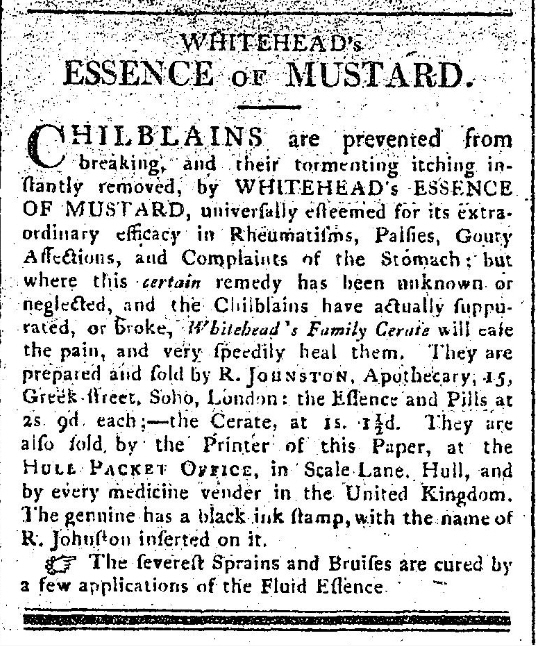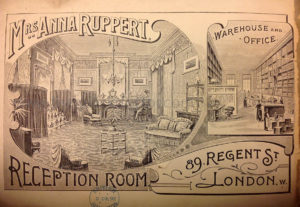
WHITEHEAD’S
ESSENCE OF MUSTARD.
—–
CHILBLAINS are prevented from breaking, and their tormenting itching instantly removed, by WHITEHEAD’s ESSENCE of MUSTARD, universally esteemed for its extraordinary efficacy in Rheumatisms, Palsies, Gouty Affections, and Complaints of the Stomach; but where this certain remedy has been unknown or neglected, and the Chilblains have actually suppurated, or broke, Whitehead’s Family Cerate will ease the pain, and very speedily heal them. They are prepared and sold by R. JOHNSTON, Apothecary, 15, Greek-street, Soho, London: the Essence and Pills at 2s. 9d. each;—the Cerate, at 1s. 1½d. They are also sold by the Printer of this Paper, at the HULL PACKET OFFICE, in Scale Lane, Hull, and by every medicine vender in the United Kingdom. The genuine has a black ink stamp, with the name of R. Johnston inserted on it.
The severest Sprains and Bruises are cured by a few applications of the Fluid Essence.
Source: The Hull Packet, 15 April 1806
—————————————————————————————————-
I tend to avoid blogging about the most widely advertised remedies because chances are they’ve already been researched by someone else, and there’s no point in a non-academic, sleep-deprived novelist trying to add anything to the sum of knowledge. So I’ve been skimming over the Whitehead’s Essence ads for ages. They crop up so often in early 19th-century newspapers that I became inured to them – probably much like early 19th-century newspaper readers. I now discover that the product inspired a satire too funny to ignore.
Whitehead’s Essence was patented in 1798, but had been been around for a few years by then. As I’ve mentioned before, one of the conditions of obtaining a patent was that the inventor had to file a specification detailing how to make the product. No one, however, would necessarily test out the recipe, so it was possible to get away with vague or nonsensical instructions. The author of the 1805 publication Essays on Quackery encountered this when he planned to use patents to find out the composition of various remedies. An acquaintance advised him not to bother: ‘Your recipes on specifications in the patent office will assuredly err, for, although I believe each is given in with the solemnity of an oath, it is doubtful whether any one be true.’
Robert Johnston, owner of the Essence of Mustard, submitted a long and complicated process that would be impossible to replicate without losing the will to live. The Edinburgh Medical and Surgical Journal called it ‘a motley group of ingredients,’ and The Medical Observer asked ‘Does not the grant of a patent for such a most absurd and ridiculous recipe, casts (sic) an indelible disgrace on our country?’ Rather than granting Johnston a patent, they said, the government should have ‘granted a warrant for taking him into custody, and inflicted on him some condign punishment.’
The real recipe was much simpler – oil of turpentine with spirit of rosemary and camphor, plus a small quantity of flour of mustard. Turpentine had long been used as a remedy for chilblains, so there wasn’t much new about this product, but it was famous enough to be known in the US within a few years of being established. And that’s where an amusing parody appeared in March 1798.
The article in Philadelphia’s Weekly Magazine is purportedly a letter from a farrier who has just discovered a wonderful remedy – Blackhead’s Essence of Pitchfork. The writer first condemns the medical profession for charging a fortune for ‘words and wind’:
Apply to a physician—what does he do for you? He feels your pulse; tells you, what you knew before, that you are sick ; takes the fee ; and then packs you off to the apothecary. How long will people be gulled by these men!
He then goes on to introduce the Essence of Pitchfork:
It has been universally acknowledged, that pitchforks are very useful and essential, but rather irritating and inconvenient when taken in their natural state.
The Essence would cure everything, including wooden legs and drowning, and was available in two forms, ‘viz. Sharp, powerful steel points, for internal use, and hickory staff for external’ – a reference to Whitehead’s being available as both a topical preparation and as pills. The article concludes with these testimonials, mocking the whole breed of advertisers who used exaggerated stories to try and sell their remedies:
I DO hereby solemnly declare and affirm, that, as I was walking up Arch-street in January last, I slipped, and tumbled to pieces: By a judicious and timely application of Blackhead’s Essence of Pitchfork, the parts were gathered together, without the loss of a single member.
Jedediah Scarramouch
March 14, 1798
HAVING died some time ago, to the great grief of my dear wife, she applied Blackhead’s Essence of Pitchfork, in staff, to my poor corse. Symptoms of returning life soon appeared, and in a few weeks I was all alive.
Count Obadiah.
March, 1798.
I DO hereby certify, that I used to be as thin and poor as a snake, and was subject to being drowned. I purchased some of Blackhead’s Essence of Pitchfork, and, in due season, grew as fat as a pig, and have never been drowned since.
Joban Nincum.
March, 1798.



New blog post – Whitehead’s Essence of Mustard – spoof testimonials included: http://thequackdoctor.com/index.php/whit… #history
RT @quackwriter: New blog post – Whitehead’s Essence of Mustard – spoof testimonials included: http://thequackdoctor.com/index.php/whit… #history
RT @quackwriter: New blog post – Whitehead’s Essence of Mustard – spoof testimonials included: http://thequackdoctor.com/index.php/whit… #history
RT @quackwriter: New blog post – Whitehead’s Essence of Mustard – spoof testimonials included: http://thequackdoctor.com/index.php/whit… #history
Never liked mustard for anything including food!
Another interesting post 🙂
E
Thank you – glad you liked the post.
Lord Gnome is older than we thought! Marvellous 🙂
I was quite surprised to discover it was American, as it seems such a British kind of humour!
Final pimp of latest blog post – Whitehead’s Essence of Mustard for chilblains: http://thequackdoctor.com/index.php/whit… #history
RT @quackwriter
Final pimp of latest blog post – Whitehead’s Essence of Mustard for chilblains: http://thequackdoctor.com/index.php/whit… #history
RT @quackwriter: Final pimp of latest blog post – Whitehead’s Essence of Mustard for chilblains: http://thequackdoctor.com/index.php/whit… #history
My grandmother was a devotee of a mustard plaster: a pasty mix of dry mustard, flour, and water spread thickly on a piece of flannel, and then applied to the chest or back until the skin was inflamed and you couldn’t tolerate it anymore. In this way, she treated us for bronchitis, pneumonia, and once saved the life of our dog, fluffy, who had distemper, according to the vet.
Sounds like a similar principle to Thermogene, but more economical. Great to hear that it worked and that Fluffy survived distemper.
Have you done any research on the use & sale of snake oil, especially in the 19th cen. on the American frontier? I have done some digging on the subject and it is difficult to separate fact from sensationalism… wondering if you have any info…
Thanks!
‘The Babes in the Wood’ or ‘A legend of Norfolk’ in The Ingoldsby Legends, published in 1866 has the couplet: “And mind Johnny’s chilblains are rubb’d, Well with Whitehead’s best essence of mustard”.